Roxane Legenstein is the quintessential itinerant artist. Having traveled, worked and lived in a variety of cities, Legenstein has created opportunities to produce specific artwork for exhibitions in Austria, Russia, Ukraine, and the United States. In addition, as an educator, Legenstein has utilized this journey to introduce her students to an evolving worldview. The COMP Magazine recently caught up with Legenstein in her Vienna studio to discuss the impact a city or rural environment has had on her practice, straddling abstract and narrative visual approaches, what she values in the art making process, and the influences upon her extensive career as an artist.
In the time I have known you, I would describe you as an adaptable traveling spirit. You’ve lived and worked in various locals in the states and Europe. Does the city you are working in have any impact on informing your artistic practice? Were there any distinct items that surfaced while living in Chicago?
Of course, it has an impact. For example, when I was looking for a place to work and live on the island of Crete I happened to end up in a village with a more than a thousand year old history of making ceramics. There, I started to work with clay. In Chicago, a city of iron and steel, I found my material on the shores of Lake Michigan. Very fine iron ore sand, I combined the sparkling black iron powder with flakes of copper, silver and gold to produce objects one can use as tapestry or stretched on frames like paintings. Since I am back in Austria, I work in a studio in the Vienna woods. Consequently, the main themes of my recent work are influenced by nature: stones, trees, insects, flowers, …
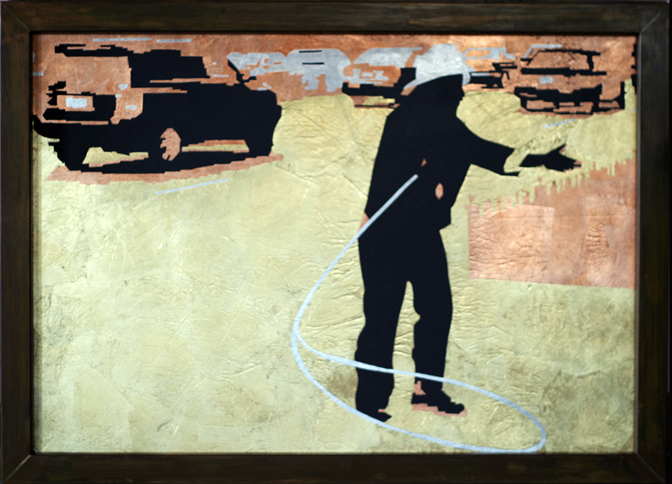
Roxane Legenstein, magnificent mile: gold, silver, copper and iron sand on vinyl in iron frame, 2010 (series: MetalWorld)
40 x 28 in.
Often, your work straddles abstraction and narrative formats of visual representation. Where are you cultivating your aesthetic oeuvre? Are there specific principles or philosophies that you hope to convey in your work?
Well, it’s hard to describe one’s own aesthetics. What you call my “straddling” between abstraction and narrative formats might come from my awareness of time. I am constantly strangely aware that the ground I am walking on was once a shield of ice or even an ocean and that it might become an ice shield again. I am very interested in history – not only the history of mankind, but the history of our planet and the universe – the constant shift and movement. When it comes to people, I am deeply convinced that we as a species don’t change. The tools in use to fulfill desires, pursue aims or satisfy yearnings might change, but not desires, yearnings or personal aims in themselves. That’s how I see the world and my existence in it. Therefore, I feel sometimes quite strange, forlorn and very skeptical about everything that’s called “new” or “true”. The newest medical treatment? Well, in 200 years people will roll their eyes like we do now when we think about venesection. It’s no wonder that I love the Chariot of Delphi as much as certain sculptural objects by Joseph Beuys. Because of my constant awareness of time as the 4th dimension we live in I use the space of my art work to suggest time.
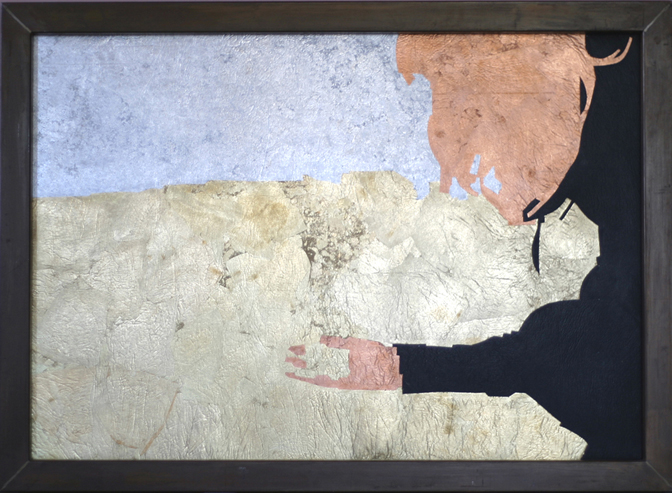
Roxane Legenstein, self-portrait (collecting iron sand), series: MetalWorld, gold, silver, copper and iron sand on vinyl in iron frame, 2010, 40 x 28 in.
What do you value in your art practice?
Curiosity, invention… lots of trial, the acceptance of “failure”, and the use of this for further inventions. What I care most about is the material I am working with. Material talks (to me). I like to “listen” to the material I find interesting or fall in love with, and then I look for the right material to combine together. Very often, I combine natural material with industrial material. Similarly to how I combined the iron ore with sand together with the metal flakes upon vinyl. And, since vinyl responds according to the surrounding temperature, I stabilized the combination with iron-on interfacing fabric. Altogether, this took me four years to complete the series. The exploration was a lot of trial and error till the combination was exactly the way I just knew the result is right. The artwork had to have the exact haptic feel and look I had in my mind. One can say that I have my head in the clouds and my eyes on the ground. I like to dig and collect things I find on my travels. I am an avid walker and hiker.
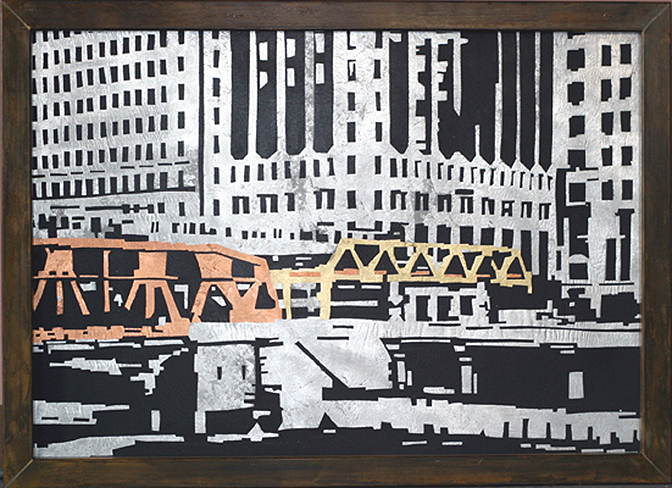
Roxane Legenstein, Chicago: gold, silver, copper and iron sand on vinyl in iron frame, 2010, (series: MetalWorld), 40 x 28 in.
Are there any specific artists or writings that pique your interest or influence your current investigations?
Since I am also teaching art, I am becoming increasingly annoyed by the “-isms” of the 20th century. All the manifestos seem to be so outdated and can only be understood in connection with the frantic political “-isms” of that specific time. I don’t like to put art in “-ism” boxes. So, when it comes to writings I always come back to Hegel’s “Lectures on Aesthetics”. I read this in German (and eventually in English while at Sleeping Bear Dunes in Michigan during an Artist Residency). Right now I discover with passion gothic art. I like their fineness and precision. Of living artists I admire Anselm Kiefer.
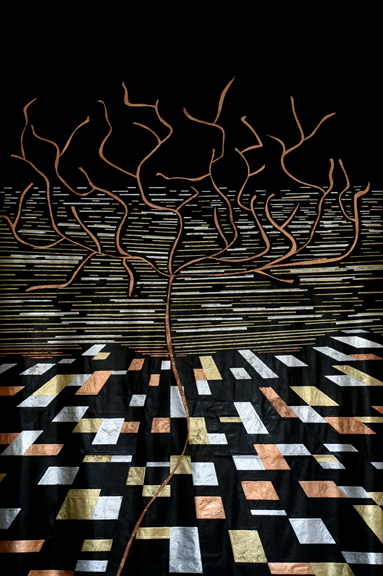
Roxane Legenstein, Chicago (Series: Cities, remembered), 47 x 67 in. , 2007, gold, silver, copper and iron sand on vinyl
Has your art practice changed since returning to Austria? Do you see any distinct differences between the art community in Vienna versus that found in Chicago?
My art practice doesn’t change much, but depends in some ways on the available space. If I have a great deal of space my studio tends to be quite chaotic. Now, I am working in a small studio, which is very neat and organized.
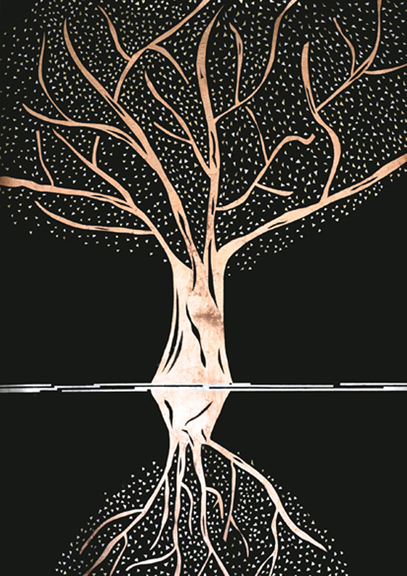
Roxane Legenstein, Vienna (Series: Cities, remembered), 47 x 67 in., 2008, gold, silver, copper and iron sand on vinyl
Regarding the differences between the art communities in Vienna and Chicago, I don’t think that there exists something like one art community in any city. Here and there you can find many different art communities who are only combined in their member’s dance around the big players in the art market which is a global market like any market. Every artist tries to find powerful dance partners with money and influence. But, when we consider art community as a group of artists who know each other personally I can say that there is a big difference between Chicago and Vienna. Chicagoan artists are very supportive of their friend’s and peer’s work. One can hear a lot for “great” and “fantastic” and there is a generous use of the word “genius”. Noticeable is also a great admiration of successful artists which makes it almost impossible to question their work. If you do, people deem you as just jealous. In Vienna, there is much more criticism among artists. I think Europeans are more skeptical. Therefore, artists too, frequently question the road to success, and don’t shy away from criticizing art – no matter if the artist is famous or not. That criticism isn’t necessarily harsh – at least in Vienna. however, the most devastating criticism is making fun of artists and their work. What it comes down to is “That’s awesome! You are such a genius!” versus “He/she really knows how to paint – but why waste that knowledge on that kind of paintings?”
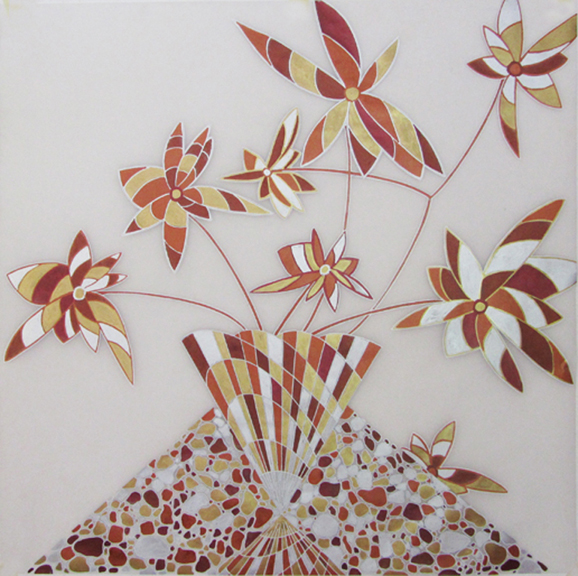
Roxane, Legenstein, Flowers, 2015, leafing pen on transparent paper, (Series: Wienerwald)
When I moved to Chicago, at first, I considered artist’s discussions as quite boring, but when I moved back to Vienna I had – and still have – a hard time adjusting. Now, I reside somewhere in the middle. I can say that I actually don’t talk much about art anymore. I teach art and that’s enough talk for me.
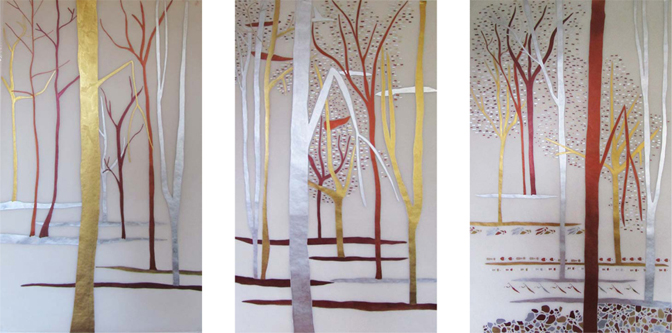
Roxane Legenstein, Wienerwald I – Series, 2013-14, 30 x 40 in. each, leafing pen on transparent paper
What are you currently working upon? What’s your focus for 2015?
I just finished an installation with the title “Stille.Silence.Silentium”. This work will be on display for the next 2 years at Gut Gasteil in Austria. The basic idea was to create a space where people can rest and contemplate – the space, similarly to churches, function like islands of silence in a bustling cities. But, because religions with all their laws and regulations are booming right now, I didn’t allow myself any hint to a certain religion which isn’t easy when you plan to make a kind of “sacred” space. I was raised as a so-called “Sunday-Roman-Catholic” (that’s the Catholics who like free Sundays and Holidays and a baroque lifestyle in a cycle of sin, confession and forgiveness). And, that’s why I am naturally drawn to the opulent art-work of our churches, the music of Haydn, Mozart and Bruckner. I heard these musicians first as a child while experiencing the stained glass windows. The study of Sigmund Freud’s “The future of an illusion”, his central work on religion, helped me not to fall into any religious trap. The design of the windows turned out to be the biggest challenge – till I decided to use the Hyperbolic Mosaic of Coxeter, a geometer who influenced M.C. Escher.
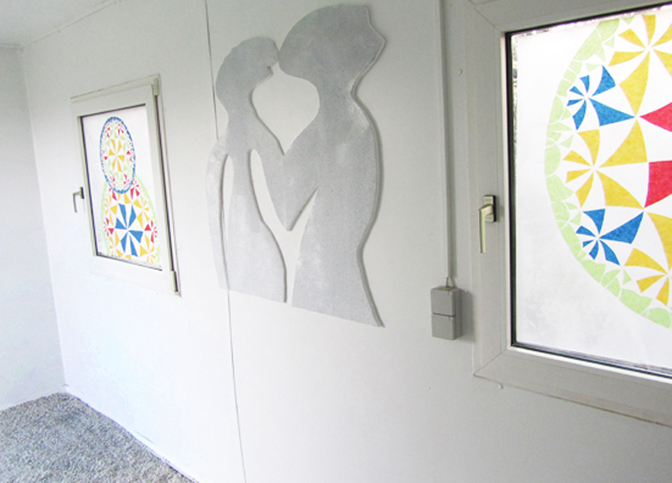
Roxane Legenstein, STILLE.SILENCE.SILENTIUM Installation, 2015
In my studio, I am currently still working on my series “Wienerwald” (Vienna Woods), drawings made with leafing pens on transparent paper.
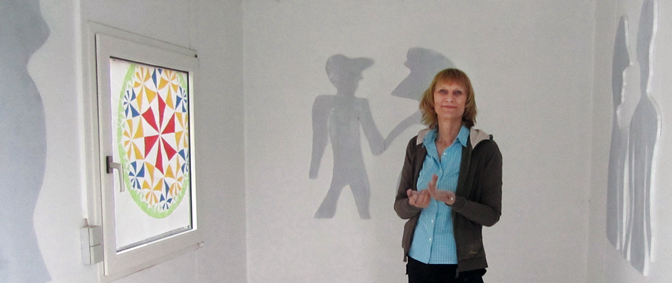
Roxane Legenstein, STILLE.SILENCE.SILENTIUM Installation, 2015
Roxane Legenstein has been a visiting artist at the School of the Art institute of Chicago, and taught at the Marwen Foundation, and in the Art & Design Department at the University of St Francis (Joliet, IL). Her work has been exhibited at the Ukrainian Institute of Modern Art (Chicago), Gut Gasteil (Austria), Express Avantgarde Gallery (Moscow), Art Palace (Kiev) and other venues.
For additional information on the work of Roxane Legenstein, please visit:
Roxane Legenstein – http://www.roxanelegenstein.org
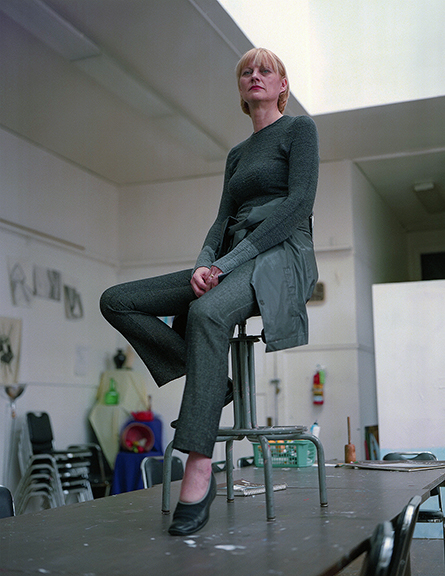
Roxane Legenstein, artist, Joliet, IL, 2003
Interview and portrait by Chester Alamo-Costello


